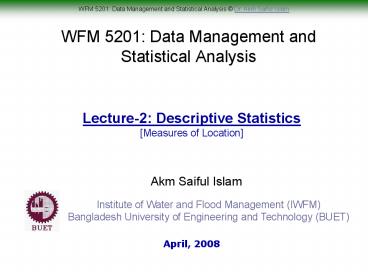WFM 5201: Data Management and Statistical Analysis - PowerPoint PPT Presentation
1 / 12
Title:
WFM 5201: Data Management and Statistical Analysis
Description:
... and percentiles, because they are also based on their position in a series ... they describe the position of one score relative to the others ... inspection ... – PowerPoint PPT presentation
Number of Views:48
Avg rating:3.0/5.0
Title: WFM 5201: Data Management and Statistical Analysis
1
WFM 5201 Data Management and Statistical Analysis
Lecture-2 Descriptive Statistics Measures of
Location
- Akm Saiful Islam
Institute of Water and Flood Management
(IWFM) Bangladesh University of Engineering and
Technology (BUET)
April, 2008
2
Descriptive Statistics
- Measures of Central Tendency
- Measures of Location
- Measures of Dispersion
- Measures of Symmetry
- Measures of Peakdness
3
Measures of Location
- Measures that are allied to the median include
the quartiles, deciles and percentiles, because
they are also based on their position in a series
of observations. - These measures are referred to as measures of
location and not the measures of central tendency
as they describe the position of one score
relative to the others rather than the whole set
of data.
4
Measures of Location
- Quartile
- One fourth (1/4)
- First (1/4), Second (1/2), Third (3/4)
- Decile
- One tenth (1/10)
- 10, 20, 90
- Percentile
- One of hundreds (1/100)
- 1, 2, .99
5
Quartile
- L0 Lower limit of the i-th Quartile class
- n Total number of observations in the
- distribution
- h Class width of the i-th Quartile class
- fi Frequency of the i-th Quartile class
- F Cumulative frequency of the class prior to
- the i-th quartile class
6
Decile
- L0 Lower limit of the i-th Decile class
- n Total number of observations in the
- distribution
- h Class width of the i-th Decile class
- fi Frequency of the i-th Decile class
- F Cumulative frequency of the class prior to
- the i-th Decile class
7
Percentile
- L0 Lower limit of the i-th Percentile class
- n Total number of observations in the
- distribution
- h Class width of the i-th Percentile class
- fi Frequency of the i-th Percentile class
- F Cumulative frequency of the class prior to
- the i-th Percentile class
8
Example-1 Percentile of Ungroup data
- Consider the observations 11, 14, 17, 23, 27, 32,
40, 49, 54, 59, 71 and 80. To determine the 29th
percentile? - we note that which is not
an - integer. Thus the next higher integer 4 here
will determine the 29th percentile value. On
inspection P29 23
9
Example-2 Find 3rd Quartiles, 1st Decile and
29th Percentile
Marks No. of students Cumulative frequencies
40-50 6 6
50-60 11 17
60-70 19 36
70-80 17 53
80-90 13 66
90-100 4 70
Total 70
10
Example-3 Find 30th percentile
Age in years Number of births Cumulative number of births
14.5-19.5 677 677
19.5-24.5 1908 2585
24.5-29.5 1737 4332
29.5-34.5 1040 5362
34.5-39.5 294 5656
39.5-44.5 91 5747
44.5-49.5 16 5763
All ages 5763 -
11
Determine Percentile Class
- First determine the percentile class.
- If, N 5736, and we have to find 30th percentile,
then percentile class will be the class which has
cumulative frequency below
12
30th Percentile class
1728.9
Age in years Number of births Cumulative number of births
14.5-19.5 677 677
19.5-24.5 1908 2585
24.5-29.5 1737 4332
29.5-34.5 1040 5362
34.5-39.5 294 5656
39.5-44.5 91 5747
44.5-49.5 16 5763
All ages 5763 -































